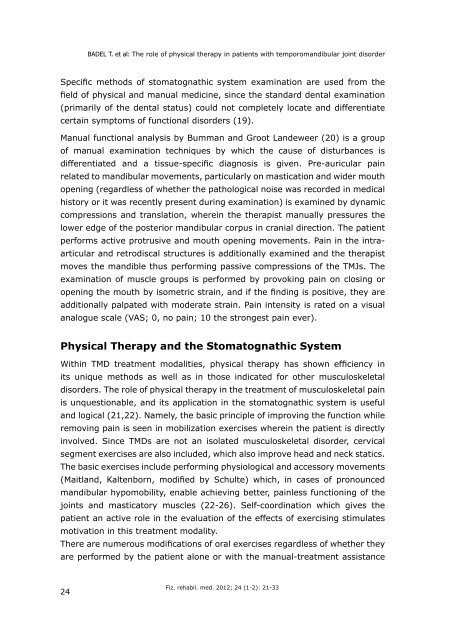2012-1-2 - Hrvatsko društvo za fizikalnu i rehabilitacijsku medicinu ...
2012-1-2 - Hrvatsko društvo za fizikalnu i rehabilitacijsku medicinu ...
2012-1-2 - Hrvatsko društvo za fizikalnu i rehabilitacijsku medicinu ...
You also want an ePaper? Increase the reach of your titles
YUMPU automatically turns print PDFs into web optimized ePapers that Google loves.
24<br />
BADEL T. et al: The role of physical therapy in patients with temporomandibular joint disorder<br />
Specific methods of stomatognathic system examination are used from the<br />
field of physical and manual medicine, since the standard dental examination<br />
(primarily of the dental status) could not completely locate and differentiate<br />
certain symptoms of functional disorders (19).<br />
Manual functional analysis by Bumman and Groot Landeweer (20) is a group<br />
of manual examination techniques by which the cause of disturbances is<br />
differentiated and a tissue-specific diagnosis is given. Pre-auricular pain<br />
related to mandibular movements, particularly on mastication and wider mouth<br />
opening (regardless of whether the pathological noise was recorded in medical<br />
history or it was recently present during examination) is examined by dynamic<br />
compressions and translation, wherein the therapist manually pressures the<br />
lower edge of the posterior mandibular corpus in cranial direction. The patient<br />
performs active protrusive and mouth opening movements. Pain in the intra-<br />
articular and retrodiscal structures is additionally examined and the therapist<br />
moves the mandible thus performing passive compressions of the TMJs. The<br />
examination of muscle groups is performed by provoking pain on closing or<br />
opening the mouth by isometric strain, and if the finding is positive, they are<br />
additionally palpated with moderate strain. Pain intensity is rated on a visual<br />
analogue scale (VAS; 0, no pain; 10 the strongest pain ever).<br />
Physical Therapy and the Stomatognathic System<br />
Within TMD treatment modalities, physical therapy has shown efficiency in<br />
its unique methods as well as in those indicated for other musculoskeletal<br />
disorders. The role of physical therapy in the treatment of musculoskeletal pain<br />
is unquestionable, and its application in the stomatognathic system is useful<br />
and logical (21,22). Namely, the basic principle of improving the function while<br />
removing pain is seen in mobili<strong>za</strong>tion exercises wherein the patient is directly<br />
involved. Since TMDs are not an isolated musculoskeletal disorder, cervical<br />
segment exercises are also included, which also improve head and neck statics.<br />
The basic exercises include performing physiological and accessory movements<br />
(Maitland, Kaltenborn, modified by Schulte) which, in cases of pronounced<br />
mandibular hypomobility, enable achieving better, painless functioning of the<br />
joints and masticatory muscles (22-26). Self-coordination which gives the<br />
patient an active role in the evaluation of the effects of exercising stimulates<br />
motivation in this treatment modality.<br />
There are numerous modifications of oral exercises regardless of whether they<br />
are performed by the patient alone or with the manual-treatment assistance<br />
Fiz. rehabil. med. <strong>2012</strong>; 24 (1-2): 21-33


